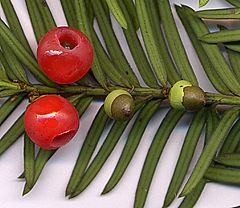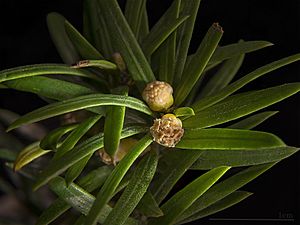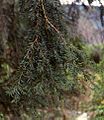Yew facts for kids
Quick facts for kids Yew |
|
|---|---|
 |
|
| Taxus baccata (European Yew) shoot with mature and immature cones |
|
| Scientific classification | |
| Kingdom: | |
| Division: | |
| Class: | |
| Order: | |
| Family: |
Taxaceae
|
| Genus: |
Taxus
|
A Yew is a type of coniferous tree. These trees are known for their needle-like leaves and often bright red, berry-like fruits. Most Yew trees belong to the group called Taxus, which is part of the Taxaceae plant family.
Contents
Why are Yew Trees Poisonous?
Yew trees contain strong natural chemicals called taxanes. These chemicals are very poisonous. Almost every part of the Yew tree has these taxanes. This includes the leaves, bark, and even the seeds inside the red berries.
The bright red, fleshy part of the Yew fruit, called an aril, is the only part that is not poisonous. It is actually sweet and can be eaten. However, the small, hard seed inside this red aril is extremely dangerous. If a human eats the seeds, their stomach can break down the seed's outer layer. This releases the taxanes into the body, which can be very harmful. It is important to never eat Yew berries without removing the seeds first.
Animals and Yew Poison
Some animals are affected by Yew poison differently. For example, the leaves and seeds of Yew trees can kill cattle and horses. However, deer can safely eat Yew leaves. They have a way to break down the poisons in their bodies. Because deer eat so much Yew foliage, wild Yew trees often grow only in places deer cannot reach, like on cliffs.
The leaves of Yew trees are also a food source for the larvae (young forms) of some Lepidopteran insects. One example is the Willow Beauty moth.
What Does a Yew Tree Look Like?
Yew trees grow slowly but can live for a very long time. They can reach heights of 1 to 40 meters (about 3 to 130 feet). Their main trunk can grow up to 4 meters (about 13 feet) wide.
Yews have reddish bark. Their leaves are flat and shaped like a spear. They are dark green, usually 1 to 4 cm long and 2 to 3 mm wide. The leaves grow in a spiral pattern around the stem. However, their bases twist so the leaves appear to be in two flat rows on either side of the stem.
Yew Tree Reproduction
The seed cones of a Yew tree are quite special. Each cone holds a single seed. This seed is 4 to 7 mm long. It is partly covered by a special scale that grows into a soft, bright red, berry-like structure. This red part is called an aril. It is 8 to 15 mm long and wide and open at one end.
The arils become ripe about 6 to 9 months after the tree is pollinated. Birds like thrushes and waxwings eat these red arils. They then spread the hard, undamaged seeds in their droppings. This helps new Yew trees grow in different places.
Male Yew cones are round and small, about 3 to 6 mm across. They release their pollen in early spring. Most Yew trees are dioecious. This means a single tree will have either male cones or female cones, but not both. However, sometimes a Yew tree can have both male and female cones (called monoecious), or even change its sex over time.
All types of Yew trees are very closely related. They are often grouped together and simply called Taxus baccata.
Images for kids
-
Foliage of Mexican yew




